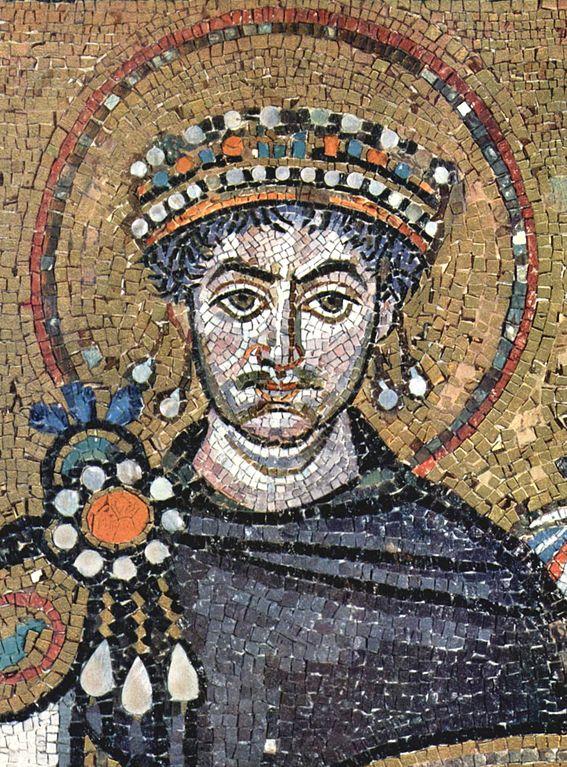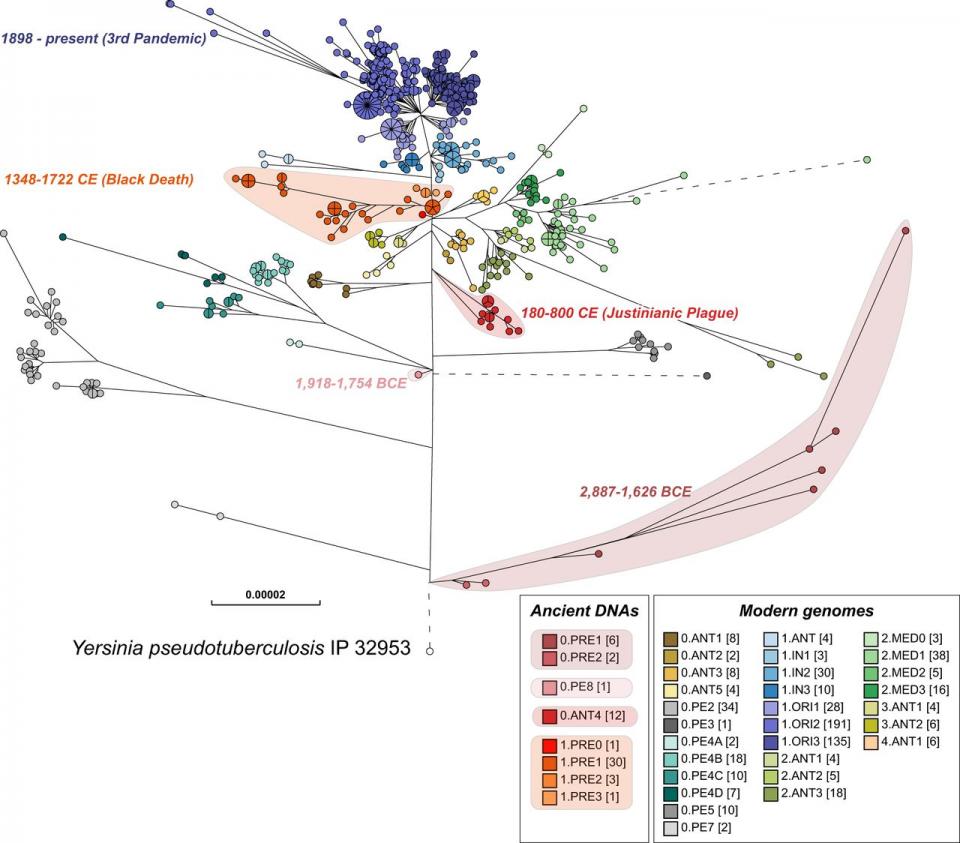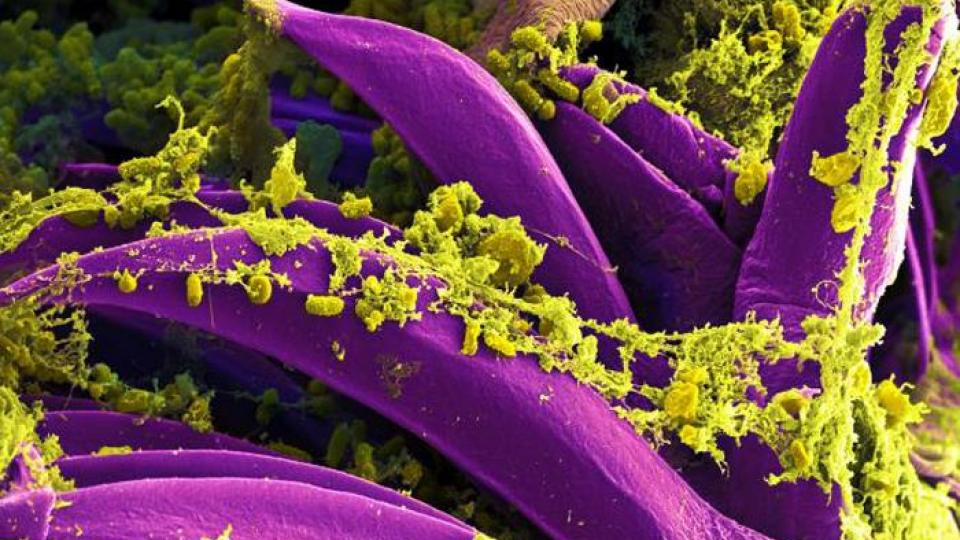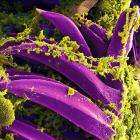
Emperor Justinian I (r. 527–565 CE).
Emperor Justinian I (r. 527–565 CE).
Unknown artist, n.d. (prior to 547)
Accessed via Wikimedia on 11 August 2020. Click here to view source.
 This work is licensed under a Creative Commons Public Domain Mark 1.0 License.
This work is licensed under a Creative Commons Public Domain Mark 1.0 License.
In the year 541 CE, the Eastern Roman Empire was in the midst of a major transformation led by its dynamic emperor Justinian I (527–565). Determined to expand his authority everywhere, the emperor initiated a major legal reform, promoted a single religious orthodoxy, authorized an empire-wide architectural building spree, and ordered military campaigns to reconquer lost territories in North Africa, Italy, and Iberia.
Then, unexpectedly, the plague struck the city of Pelusium in Egypt. Soon afterward, it reached Constantinople, the empire’s capital and the most populous city in western Eurasia. Eyewitnesses described thousands of deaths per day at the outbreak’s height. Additional outbreaks recurred over the next two centuries around the Mediterranean and beyond. Many scholars (e.g., Harper 2017) believe the plague killed up to half the population in the region—somewhere between 15 and 25 million people—in a few years and contributed to the fall of the Roman Empire, the early Islamic Conquests, and the end of antiquity.
The effects of the Justinianic Plague have recently become the focus of an intense debate. After re-examining old evidence and introducing new data, we have argued that the Justinianic Plague was inconsequential demographically and not a significant factor in any large-scale historical processes. Despite the plague, Justinian’s legal reforms were solidified, his building program and religious policies continued, and even the military campaigns were not affected.
This historical debate over the plague’s impact has expanded into scientific disciplines, particularly paleogenetics. Using new scientific techniques, scholars have extracted the DNA of the plague pathogen, Yersinia pestis, from human remains to confirm that this infamous bacterium caused both the Justinianic Plague and the Black Death. Encouraged by this finding, some historians believe paleogenetics can go a step further. Monica Green, a leading voice at the interface between history and paleogenetics, has been a proponent of harnessing the results from genetics. She claims that by using tools such as phylogenetic trees, a stemma-type figure that organizes DNA strains evolutionally, historians can “ask some of the questions real epidemiologists do: Why is this specific disease presenting [sic] here? Why in these populations? Where did it come from in the first place, and by what pathways did it (will it) spread?” This approach to tracking the evolution of the biological agent resonates among the public and experts during the COVID-19 pandemic, although even today tracking the evolution of the virus tells us little about its social, cultural, political, and economic effects.

The most recent phylogenetic tree (2019) of Y. pestis, the plague pathogen. The Justinianic Plague genomes are the ones in red near the center of the figure.
The most recent phylogenetic tree (2019) of Y. pestis, the plague pathogen. The Justinianic Plague genomes are the ones in red near the center of the figure.
Originally published in:
Zhou, Zhemin, et al. “The EnteroBase user’s guide, with case studies on Salmonella transmissions, Yersinia pestis phylogeny, and Escherichia core genomic diversity.” Genome Research 30 (2020): 138–152.
Click here to view source.
 This work is licensed under a Creative Commons Attribution 4.0 International License.
This work is licensed under a Creative Commons Attribution 4.0 International License.
Other scholars, however, remain skeptical. Kristina Sessa, for example, has pointed out the disconnect between historians and geneticists: each asks different questions and looks for different answers. Since paleogenetics cannot answer demographic questions in the foreseeable future, historians should leave the phylogenetic trees to molecular biologists and focus instead on their traditional strengths by examining political, social, and cultural effects.
Such skepticism is hardly new. After two decades of paleogenetics research, thousands of attempts to identify the pathogen, and millions of dollars spent, as of mid-2020 the total number of identified Y. pestis cases from the Justinianic Plague is still under 50, a far cry from the millions the plague supposedly killed. Many additional challenges—ranging from the amount of human remains available to study, to the financial costs of conducting DNA research, to the ethics of extracting DNA from human remains—seem currently insurmountable.
Green, however, sidesteps these concerns to make direct connections with historical events. Drawing upon the 1918 influenza and the AIDS pandemics, she claims that even if few died in percentage terms, “the economic and cultural impact [of disease] was profound.” However, this statement assumes historical effects based on the existence of a disease, rather than considering research that indicates, for example, that such effects of the 1918 influenza pandemic were not significant. Moreover, such an approach not only obviates the need to investigate the sources for the purported evidence of these effects, but also ignores the massive variability between different local outbreaks as has been recently demonstrated by COVID-19.

Yersinia pestis bacteria (colored in green), that had gathered on the digestive system of a flea (purple).
Yersinia pestis bacteria (colored in green), that had gathered on the digestive system of a flea (purple).
Photograph by National Institute of Allergy and Infectious Diseases (NIAID), 2011.
Click here to view source.
 This work is licensed under a Creative Commons Public Domain Mark 1.0 License.
This work is licensed under a Creative Commons Public Domain Mark 1.0 License.
The debates surrounding the Justinianic Plague are part of a broader discussion about the discipline of history and its place in academia. Scholars from non-historical, often scientific, fields who have minimal historical training have begun to use historical tools to investigate the past, for example with high media visibility studies that explain historical change through climatic cooling. Given the greater public visibility of scientific articles, which rarely include historians as co-authors, historians have pushed back against the creeping colonization of the past, formerly their almost exclusive purview—a process sometimes described as “scientific imperialism.”
The plague debate is just an example of how contemporary developments are forcing historians to reflect on new types of evidence and re-draw the boundaries of their discipline. Has history reached “peak document,” as former American Historical Association president John McNeill recently asked? Should historians adopt methodologies and questions from other, non-adjacent disciplines such as epidemiology? And how should historians apply traditional skills such as close reading to these new sources? Our work on the Justinianic Plague suggests that traditional historical approaches such as critical thinking are necessary but insufficient. The future frontiers of the discipline will be shaped by critically-evaluated interdisciplinary collaborations that investigate historical questions. Potential paths forward might include using infectious disease modeling to illuminate the variability of plague effects, examining how nutrition and co-morbidity influence plague mortality, and focusing on local outbreaks in their specific ecological contexts.
How to cite
Mordechai, Lee, and Merle Eisenberg. “Plague, Paleogenetics, and the Boundaries of the Discipline of History.” Environment & Society Portal, Arcadia (Summer 2020), no. 30. Rachel Carson Center for Environment and Society. https://doi.org/10.5282/rcc/9088.
ISSN 2199-3408
Environment & Society Portal, Arcadia
 This work is licensed under a Creative Commons Attribution 4.0 International License.
This work is licensed under a Creative Commons Attribution 4.0 International License.
2020 Lee Mordechai and Merle Eisenberg.
This refers only to the text and does not include any image rights.
Please click on the images to view their individual rights status.
- Eisenberg, Merle, and Lee Mordechai. “The Justinianic Plague: An Interdisciplinary Review.” Byzantine and Modern Greek Studies 43, no. 2 (2019): 156–80. https://doi.org/10.1017/byz.2019.10.
- Green, Monica. “When Numbers Don’t Count: Changing Perspectives on the Justinianic Plague.” Eidolon, 18 November 2019.
- Harper, Kyle. The Fate of Rome: Climate, Disease, and the End of an Empire. Princeton: Princeton University Press, 2017.
- Keller, Marcel, Maria A. Spyrou, Christiana L. Scheib, Gunnar U. Neumann, Andreas Kröpelin, Brigitte Haas-Gebhard, Bernd Päffgen, et al. “Ancient Yersinia pestis Genomes from Across Western Europe Reveal Early Diversification During the First Pandemic (541–750).” Proceedings of the National Academy of Sciences 116, no. 25 (2019): 12363–72. doi:10.1073/pnas.1820447116.
- Mordechai, Lee, and Merle Eisenberg. “Rejecting Catastrophe: The Case of the Justinianic Plague.” Past & Present 244, no. 1 (2019): 3–50. doi:10.1093/pastj/gtz009.
- Mordechai, Lee, Merle Eisenberg, Timothy P. Newfield, Adam Izdebski, Janet E. Kay, and Hendrik Poinar. “The Justinianic Plague: An Inconsequential Pandemic?” Proceedings of the National Academy of Sciences 116, no. 51 (2019): 25546–54. doi:10.1073/pnas.1903797116.
- Sessa, Kristina. “The New Environmental Fall of Rome: A Methodological Consideration.” Journal of Late Antiquity 12, no. 1 (2019): 211–55. doi:10.1353/jla.2019.0008.










